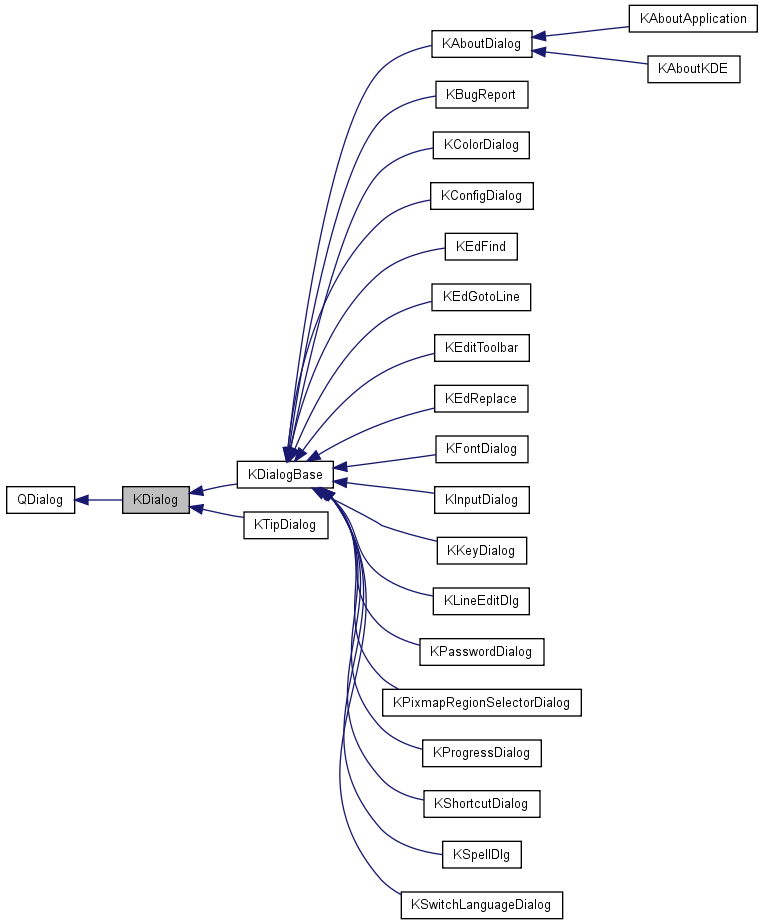kdeui
KDialog Class Reference
Dialog with extended non-modal support and methods for KDE standard compliance. More...
#include <kdialog.h>

Public Slots | |
| virtual void | polish () |
| virtual void | setCaption (const QString &caption) |
| virtual void | setPlainCaption (const QString &caption) |
Signals | |
| void | layoutHintChanged () |
Public Member Functions | |
| KDialog (QWidget *parent=0, const char *name=0, bool modal=false, WFlags f=0) | |
Static Public Member Functions | |
| static bool | avoidArea (QWidget *widget, const QRect &area, int screen=-1) |
| static void | centerOnScreen (QWidget *widget, int screen=-1) |
| static int | marginHint () |
| static void | resizeLayout (QLayoutItem *lay, int margin, int spacing) |
| static void | resizeLayout (QWidget *widget, int margin, int spacing) |
| static int | spacingHint () |
Protected Member Functions | |
| virtual void | keyPressEvent (QKeyEvent *) |
| virtual void | virtual_hook (int id, void *data) |
Detailed Description
Dialog with extended non-modal support and methods for KDE standard compliance.Generally, you should not use this class directly, but KDialogBase which inherits KDialog.
If the dialog is non-modal and has a parent, the default keybindings (escape = reject(), enter = accept(), etc.) are disabled.
The marginHint() and spacingHint() sizes shall be used whenever you layout the interior of a dialog. One special note. If you make your own action buttons (OK, Cancel etc), the space beteween the buttons shall be spacingHint(), whereas the space above, below, to the right and to the left shall be marginHint(). If you add a separator line above the buttons, there shall be a marginHint() between the buttons and the separator and a marginHint() above the separator as well.
- See also:
- KDialogBase
Definition at line 52 of file kdialog.h.
Constructor & Destructor Documentation
| KDialog::KDialog | ( | QWidget * | parent = 0, |
|
| const char * | name = 0, |
|||
| bool | modal = false, |
|||
| WFlags | f = 0 | |||
| ) |
Member Function Documentation
Places widget so that it doesn't cover a certain area of the screen.
This is typically used by the "find dialog" so that the match it finds can be read. For screen, see centerOnScreen
- Returns:
- true on success (widget doesn't cover area anymore, or never did), false on failure (not enough space found)
- Since:
- 3.2
Definition at line 205 of file kdialog.cpp.
| void KDialog::centerOnScreen | ( | QWidget * | widget, | |
| int | screen = -1 | |||
| ) | [static] |
Centers widget on the desktop, taking multi-head setups into account.
If screen is -1, widget will be centered on its current screen (if it was shown already) or on the primary screen. If screen is -3, widget will be centered on the screen that currently contains the mouse pointer. screen will be ignored if a merged display (like Xinerama) is not in use, or merged display placement is not enabled in kdeglobals.
- Since:
- 3.1
Definition at line 195 of file kdialog.cpp.
| void KDialog::keyPressEvent | ( | QKeyEvent * | e | ) | [protected, virtual] |
For internal use only.
Reimplemented in KColorDialog, and KDialogBase.
Definition at line 55 of file kdialog.cpp.
| void KDialog::layoutHintChanged | ( | ) | [signal] |
Emitted when the margin size and/or spacing size have changed.
Use marginHint() and spacingHint() in your slot to get the new values.
| int KDialog::marginHint | ( | ) | [static] |
Return the number of pixels you shall use between a dialog edge and the outermost widget(s) according to the KDE standard.
Definition at line 97 of file kdialog.cpp.
| void KDialog::polish | ( | ) | [virtual, slot] |
If the dialog starts with focus in a QLineEdit child, then call selectAll() on the child.
Definition at line 109 of file kdialog.cpp.
| void KDialog::resizeLayout | ( | QLayoutItem * | lay, | |
| int | margin, | |||
| int | spacing | |||
| ) | [static] |
Resize every layout associated with lay and its children.
- Parameters:
-
lay layout to be resized margin The new layout margin spacing The new layout spacing
Definition at line 156 of file kdialog.cpp.
| void KDialog::resizeLayout | ( | QWidget * | widget, | |
| int | margin, | |||
| int | spacing | |||
| ) | [static] |
Resize every layout manager used in widget and its nested children.
- Parameters:
-
widget The widget used. margin The new layout margin. spacing The new layout spacing.
Definition at line 133 of file kdialog.cpp.
| void KDialog::setCaption | ( | const QString & | caption | ) | [virtual, slot] |
Make a KDE compliant caption.
- Parameters:
-
caption Your caption. Do notinclude the application name in this string. It will be added automatically according to the KDE standard.
Definition at line 115 of file kdialog.cpp.
| void KDialog::setPlainCaption | ( | const QString & | caption | ) | [virtual, slot] |
Make a plain caption without any modifications.
- Parameters:
-
caption Your caption. This is the string that will be displayed in the window title.
Definition at line 122 of file kdialog.cpp.
| int KDialog::spacingHint | ( | ) | [static] |
Return the number of pixels you shall use between widgets inside a dialog according to the KDE standard.
Definition at line 103 of file kdialog.cpp.
| void KDialog::virtual_hook | ( | int | id, | |
| void * | data | |||
| ) | [protected, virtual] |
Reimplemented in KAboutDialog, KBugReport, KColorDialog, KDialogBase, KEdGotoLine, KEdFind, KEdReplace, KEditToolbar, KFontDialog, KKeyDialog, KLineEditDlg, KPasswordDialog, KProgressDialog, and KTipDialog.
Definition at line 318 of file kdialog.cpp.
The documentation for this class was generated from the following files:
 KDE 3.5 API Reference
KDE 3.5 API Reference